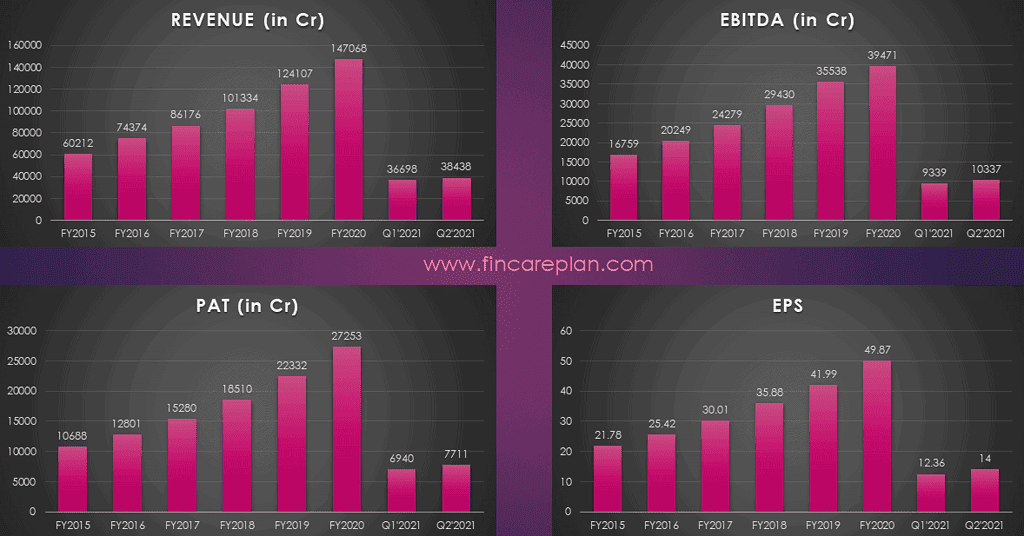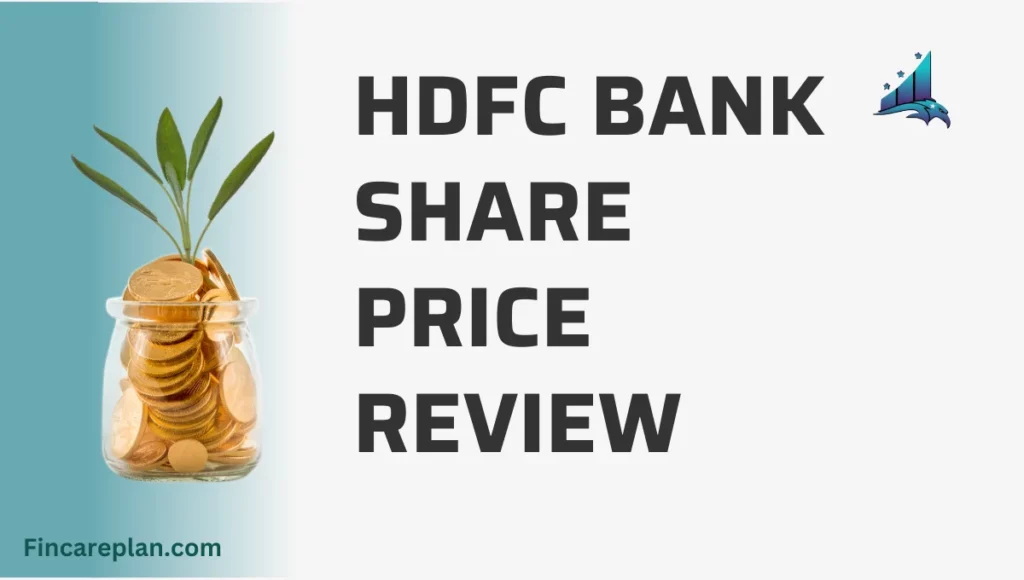Table of Contents
ToggleHDFC Bank shares the no.1 private bank by market capitalization, which is a subsidiary of HDFC. The bank was incorporated in the year 1994 and headquartered in Mumbai. The current revenue of the bank is 1.47 Trillion INR.
The largest public bank currently has 1,04,154 permanent employees. It has recently announced the Q2’2021 financial result. Net profit has grown by 18.4% compared to Q2’2020. In recent months, the legendary CEO Aditya Puri was replaced by Sashidhar Jagdishan.
In the last quarter, the CASA deposit has increased by 42%. The loan distribution decreased to 15.9% from 20.9% in the previous quarter. The total advances have risen by 15.8% in Q2’2021 compared to the previous year.
Let us understand the bank’s business behavior, financial, and fundamental analysis in detail.
Have a look at our Review on Sun TV Network Shares
Qualitative Analysis – HDFC Bank Share:
The bank is well positioned across Indian Geography. They lead the show by the following attributes,
- Leading players across retail loan categories.
- Focus on working capital finance and trade services.
- Well-positioned in Urban and Rural markets.
- Significant provider of cash management services for the public sector and semi-government undertakings.
- E-enabling public services.
- Term loans for brownfield and greenfield businesses.
- Loan Syndication, debt capital market.
- Lending working capital bankers to capital goods manufacturers.
- Project financing – Infrastructure and manufacturing.
The bank provides various products into segments, like,
1. Retail Banking:
- Loan Products – Auto Loan, Personal Loans, Home loans, Commercial vehicle loans, Retail Business Banking, Credit Cards, Gold Loans, 2-Wheelers Loan, Construction Equipment Loans, Consumer Durable Loans, Agri and Tractor Loans, Education Loans, Self Help Group Loans, Joint Liability Group Loans, Kisan Gold Card, Loan against Securities
- Deposits Products – Savings Account, Current Accounts, Fixed and Recurring Deposits, Corporate Salary Accounts, Escrow Accounts.
- Other products/Services – Depository Accounts, Mutual Fund schemes, Private Banking, Insurance Sales, NRI Services, Bill Payment Services, POS terminals, Debit Cards, Foreign Exchange Services, DEMAT securities broking.
2. Wholesale Banking:
- Commercial Banking – Working Capital, Term Loans, Bill/Invoice Discounting, Forex & Derivatives, Letters of Credit, Guarantees.
- Investment Banking – Debt Capital markets, Equity Capital Markets, Project Finance, M&A and Advisory
- Transactional Banking – Cash Management, Custodial Services, Clearing Bank Services, Correspondent Banking, Tax Collection, Banker to public issues.
- Key Segments – Large Corporations, Emerging Corporations, Financial Institutions, Government/PSUs, Business Banking/SMEs, Supply Chain, Agriculture, Commodities
3. Treasury:
- Products/Segments – Foreign Exchange, Debt Securities, Derivatives, Equities
- Other Functions – Asset Liability Management, Statutory Reserve Management.
There are many products and services that the bank offers. It will take more time to engage ourselves in detailed understanding. But, we have to understand where their business is strong or being a pioneer.
Unlike other PSUs, they don’t provide any business loans without proper securities or for any government projects. This is the biggest reason the NPA% is very low and Capital Adequacy Ratio is higher than other banks.
The bank is focused on a perfect revenue model with a huge net profit margin. They are the leaders in,
- Credit Card business.
- HDFC Securities.
- Personal, Car, and Home loans.
- HDFC Asset Management Company.
- Corporate Salary Accounts.
They have used technology greatly over the years, from 2010 to 2020.
- Internet and Mobile banking have grown from 35% in 2010 to 95%.
- ATM Services have come down from 34% in 2010 to 2% in 2020
- Phone Banking has completely vanished from 11% in 2010.
50% of the total banking outlets are in Semi-Urban and Rural locations.
More than 56 Million of a strong customer base. 28% of banking outlets are present in metro-cities
Financial Performance – HDFC Bank Share:
In this section, we will look at the bank revenue, EBITDA, PAT, and EPS from the last 5 years and two quarters.

From the above image, we can understand the following details,
- Revenue has grown at a CAGR of 19.55% in the last 5 years, which is higher than the industry average. The 5 years Industry average is at a CAGR of 15.99%.
- EBITDA has grown at a CAGR of 18.69%
- Net profit has grown at a CAGR of 20.59% over the last 5 years, higher than the industry average of -1.75%
- Market Share has grown from 20.91% to 24.21% over the last 5 years.
In terms of financial performance, the bank has proved why it is the favorite bank for investors.
Amid the COVID situation, the bank has come back strongly in Q2’2021 results compared to all the quarters of the previous years, and the revenue has grown by almost 16.7%.
Fundamental Analysis – HDFC Bank Share:
Number of Shares – 548.33 Cr Shares
Market Capital – Rs. 671126.79 Cr
As our readers know, the basic part of quantitative fundamental analysis is Valuation ratios.
Valuation Ratio:
Unlike others, Bank Shares will have a different set of valuation methods and aspects to understand the safety and stability of the bank.
1. Book Value:
Book value is known as the loan book of a bank. It has grown by 23% in Q2’2021 compared to the previous quarter. The current total Book value of Q2’2021 is Rs. 1609428 Cr. The book Value per Share is Rs. 321.63.
2. Price to Book value:
The P/B ratio of the current market price (CMP) is 3.81. This is too high; the share price is 3.81 times higher than the book value. P/B of a bank stock should be less than 1, ideally. Banks like HDFC, with 18% year-on-year revenue, can have a P/B of a maximum of 2. 3.81 is a worrying sign for investors.
3. Capital Adequacy Ratio (CAR):
CAR is the most important parameter to analyze before investing in bank shares. It states the percentage of capital against the total credit of the bank.
A Bank should have a minimum CAR of 15%. HDFC Bank currently has 19.1% as of Q2’2021. It was 18.5% and 17.5% in FY2020 and Q2’2020, respectively. It has shown a perfect increase in the CAR quarter on quarter.
4. Non-Performing Assets (NPA%):
NPA is the percentage of outstanding loans without any return to the total estimated asset. As NPA increases, bank stability decreases. There is no minimum threshold in NPA%. Every bank loves to keep NPA at 0, but ultimately not possible.
There are two types of NPA – Gross and Net. HDFC Bank’s current (Q2’2021) Gross NPA – is 1.08% and its Net NPA – is 0.17%. This has reduced gross NPA – by 1.38% and Net NPA -by 0.42% in Q1’2021.
In terms of NPA, the bank has also shown a great green signal for its investors of safety and stability.
5. Other Ratios:
These ratios don’t have much impact on the valuation of shares. Anyhow, we have shared it for your reference.
- Earnings per Share (TTM) – Rs. 53.96 per share.
- Price to Earnings (P/E) – 22.68
- Dividend yield – 0.2%
- 5 years EPS Growth – 18.44%
- Borrowing to Net worth ratio – 1.05 (Ideally, it should be less than 0.5)
- Loan to Deposit ratio – 91% (ideally, it should be between 81-90)
- Return on Equity – 15.45%
- Net Profit Margin – 18.53%
Check out our article on HDFC Life Click 2 Wealth Plan — Should You Choose.
Insights to Investors:
- As you see above, all pieces of information. This stock should be in everyone’s portfolio.
- The share price has grown at a CAGR of 16.6%, and the revenue has grown by 19% in the last 5 years. This is a good signal for investors.
- The only concern here is P/B, which is most important for bank stocks. The current share price is traded at nearly 4 times its book value.
- The bank and organization have focused well on establishing the market share, Capital adequacy ratio, revenue, and net profit year on year.
- At the same time, they have reduced NPA%.
